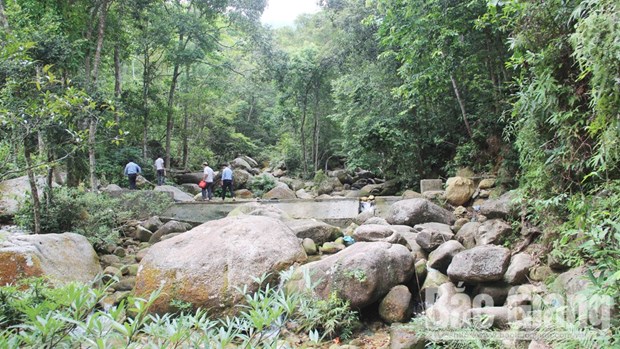Bac Giang strives to preserve biodiversity in Tay Yen Tu
 Tay Yen Tu Nature Reserve in Bac Giang (Photo: VNA)
Tay Yen Tu Nature Reserve in Bac Giang (Photo: VNA)Bac Giang (VNA) – The northern province of Bac Giang has proposed a plan for biodiversity protection at the Tay Yen Tu Nature Reserve for 2021-2030.
According to Vice Director of the provincial Department of Agriculture and Rural Development Nguyen Van Doanh, the major objectives of the plan include preserving the special-use forest in the area and building infrastructure serving the research and conservation of biodiversity in the Tay Yen Tu Nature Reserve.
The plan also aims to implement projects to support locals in socio-economic development in line with forest protection and safeguarding of biodiversity.
Doanh said Bac Giang will focus on protecting 13,300ha of special-use forest area, most of which is managed by the Tay Yen Tu Nature Reserve, while closely monitoring production and service facilities in the forest without granting new licences to exploit the special-use forest.
Tay Yen Tu Nature Reserve is home to 154 animal species, 24 of which are listed in the Vietnam Red Book and 27 are protected by the Convention on International Trade in Endangered Species of Wild Fauna and Flora, according to the preliminary survey of the University of Forestry.
It also has 1,165 floral species, including 57 named in the Vietnam Red Book.
Over the years, the locality has implemented many activities to safeguard biodiversity as well as protect and develop the forest in the Tay Yen Tu Nature Reserve, including planting and preserving special-use forest, planting markers around the forest, supporting the community development in the buffer zones, rescuing wildlife, and making biodiversity evaluations.
A number of projects had been implemented in Tay Yen Tu Nature Reserve to protect and increase its biodiversity, which is representative of the northeastern region.
The projects aim to involve residents in environmental protection, improve the reserve’s infrastructure, and protect its rare flora and fauna species by 2020, at an estimated cost of 19 billion VND (905,000 USD), 55.6 billion VND (2.65 million USD) and 16 billion VND (762,000 USD), respectively.
In 2010-2013, more than 37,170ha of forest were designated for protection by local residents, and more than 200ha of the buffer zone was reforested. In the same period, a number of international and domestic projects were implemented in an effort to protect and develop forests and biodiversity.
Additionally, in 2015, a project strived to relocate residents to areas outside of the nature reserve at a cost of more than 3.6 billion VND (171,400 USD).
The Tay Yen Tu Nature Reserve was established by Bac Giang’s Provincial People’s Committee on 22 July 2002 with the issuing of Decision No. 117/QD-UB.
Vietnam, which houses 10 percent of the world’s mammal, bird, and fish species, is also facing the risk of biodiversity loss and imbalance. More than 70 percent of the country’s population relies on agriculture and forests.
Biodiversity plays an important role in ensuring Vietnam’s food security, genetic resources, and medicine sources.
According to the Vietnam Environment Administration, since Vietnam ratified the Convention on Biological Diversity in October 17, 1994, the country has made strides in protecting the nature and biodiversity, building a system of management agencies as well as legal and policy frameworks on biodiversity.
A system of wildlife reserves has been set up, while many endangered species of animals and plants have been protected by the law and through action plans. Vietnam has also sped up the settlement of new issues related to biodiversity conservation such as biological safety, genetic resource access and interest sharing from using genetic resources.
The public awareness of the significance and role of biodiversity to the life and national sustainable development has been improved. -VNA













